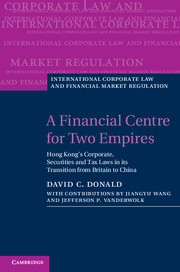 A Financial Centre for Two Empires
A Financial Centre for Two Empires Book contents
- Frontmatter
- Contents
- List of figures
- List of tables
- Preface
- 1 History’s marks on Hong Kong law
- 2 Hong Kong’s economic structure
- 3 Hong Kong corporate and securities laws in response to the Region’s role as China’s international financial centre
- 4 The role of Hong Kong’s tax policies
- 5 Enforcement of corporate and securities law in Hong Kong
- 6 China’s impact on Hong Kong’s position as an international financial centre
- References
- Index
6 - China’s impact on Hong Kong’s position as an international financial centre
the legal and policy dimensions
Published online by Cambridge University Press: 05 June 2014
- Frontmatter
- Contents
- List of figures
- List of tables
- Preface
- 1 History’s marks on Hong Kong law
- 2 Hong Kong’s economic structure
- 3 Hong Kong corporate and securities laws in response to the Region’s role as China’s international financial centre
- 4 The role of Hong Kong’s tax policies
- 5 Enforcement of corporate and securities law in Hong Kong
- 6 China’s impact on Hong Kong’s position as an international financial centre
- References
- Index
Summary
Introduction: integration, competition and erosion
Hong Kong’s ambition to maintain its position as an international financial centre – or even to become a more significant one, depends overwhelmingly on the market of mainland China (hereinafter the mainland, China or the PRC). China, however, provides a mixed blessing for Hong Kong in this regard, arising out of the inevitable co-existence of integration and competition between the two regions under Chinese sovereignty.
As the hub of China trade and investment for more than a century, Hong Kong has played a significant historical and current role in the development of the Chinese economy. Hong Kong’s importance for China, at least from an economic perspective, is beyond doubt. As noted by historian Steve Tsang, by 1997, the year Hong Kong was returned to China by the United Kingdom, ‘Hong Kong had become the largest source of investments in a very wide spectrum of economic activities and the most important capital market for the PRC … It was the PRC’s key trading partner, middleman, financier and facilitator that underpinned the economic reform of Deng Xiaoping.’ In short, ‘Hong Kong’s economy did not merge into that of the PRC in 1997 but the two economies had by then become so intricately linked that the wellbeing of one had become crucial for the other’.
- Type
- Chapter
- Information
- A Financial Centre for Two EmpiresHong Kong's Corporate, Securities and Tax Laws in its Transition from Britain to China, pp. 223 - 257Publisher: Cambridge University PressPrint publication year: 2014
- 1
- Cited by


